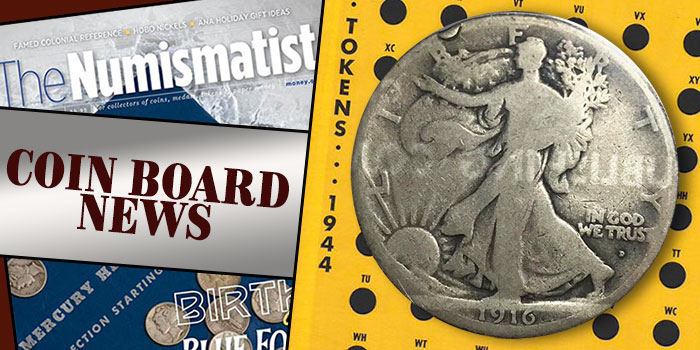
Antique Coin Boards with David W. Lange – www.coincollectingboards.com …..
For Collectors of Antique Coin Boards
Number 58 — Spring 2021
MARKET ACTIVITY
While we await our vaccinations, things have stayed rather quiet on the coin board front.
There were very few new offerings of coin boards on eBay, aside from my own (more about that story below). A number of nice pieces have been rolling over month after month, and this is likely to continue until their Buy-It-Now prices come down to reality. The lots that sold over the past quarter probably did so more on the basis of the coins contained in each board. A couple of Oberwise Mercury Dime boards, complete for all coins through 1938, were auctioned off at $415 and $500 USD, respectively. This translates into the cull values for the 1916-D and the two 1921 dimes, plus silver value for the remaining pieces. The sets may have brought a bit more were it not for the fact that the seller’s Feedback Score is among the lowest I’ve seen in more than 15 years of eBay activity.
A more meaningful sale was that of a Colonial-brand board for Shield/Liberty Head Nickels that realized $30 plus shipping in so-so condition. Longtime readers of CBN will recall the remarkable Atlanta Hoard of that company’s boards I purchased in 2008, which included about two dozen examples of this title in Near Mint or close to it.
Those boards have since been well dispersed, perhaps explaining the good price for a much lesser piece.
Last month I reported how my own eBay listings of coin boards had made a slow start, with the first few going to established mailing list customers. Well, since that time things have really picked up, with many sales to first-time buyers. Most are seeking affordable boards to fill with coins, and there’s nothing wrong with that when the boards are not rare or high grade. The biggest sellers have been boards for Lincoln Cents, with the Whitman Third Edition boards seeming to attract more buyers, perhaps because of their familiar color scheme resembling Whitman’s folders.
As of this writing, I have about 30 boards listed at my eBay store, Cagemast Coin Boards and Albums.
COVER STORY
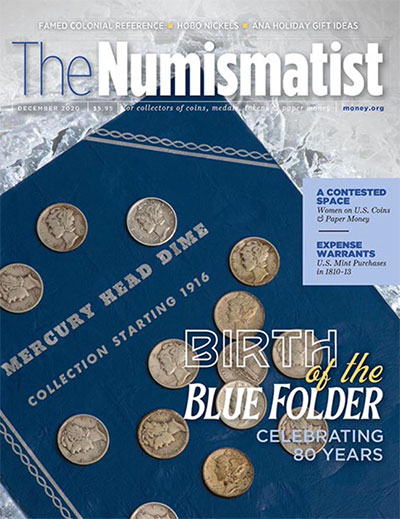 I was quite tickled that my feature article celebrating the 80th anniversary of Whitman’s iconic blue coin folders was selected to grace the cover of The Numismatist for December. It was purely a coincidence that my book on Whitman’s coin folders and albums was published in the anniversary year, but it provided the perfect opportunity to make readers aware of both events.
I was quite tickled that my feature article celebrating the 80th anniversary of Whitman’s iconic blue coin folders was selected to grace the cover of The Numismatist for December. It was purely a coincidence that my book on Whitman’s coin folders and albums was published in the anniversary year, but it provided the perfect opportunity to make readers aware of both events.
The article details the creation and marketing of Whitman’s folders during their first edition of 1940-42.
One of my treasured first printings of the Mercury Dime folder was loaned to Editor Caleb Noel and photographed by Robert B. Kelley for the ANA. It has since been returned in good order.
Sales of the book have been satisfying, especially given the hardships of this pandemic time. I was a bit distressed to discover that one small portion of my manuscript was inadvertently omitted from the printed book, but I’ve since laid out that section just as it would have appeared. This supplement is attached to the present newsletter for insertion following page 332.
OBERWISE FOLLOW-UP
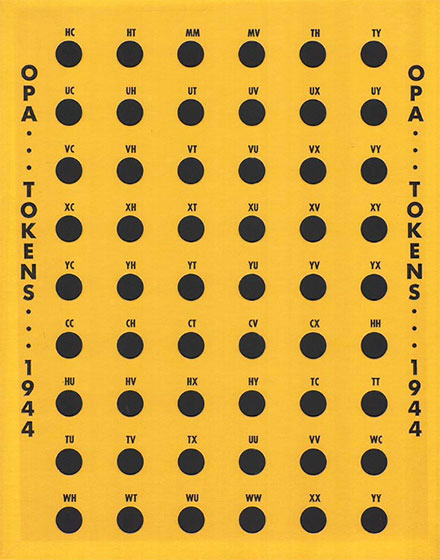 When my coin board book was published in 2007 there was very little information available to me regarding board manufacturer Joseph Oberwise. The fact that he never had any children to carry on the family name made the tracing of his family a challenge, and his biography in my book is quite sparse.
When my coin board book was published in 2007 there was very little information available to me regarding board manufacturer Joseph Oberwise. The fact that he never had any children to carry on the family name made the tracing of his family a challenge, and his biography in my book is quite sparse.
Fortunately, a descendant of Joe’s sister (her married name was Gavron) learned of the book a year or so later, and I was provided with a number of documents and photos that fleshed out Joe’s life story. I worked these into an article for Numismatic News, and a link to this piece was included in an early issue of CBN.
Among the key sources lacking when I wrote my book was the 1940 United States Census, which would have served as a snapshot taken at the height of coin board publishing. It is federal policy to withhold census information 70 years for the privacy of the individuals still living, the premise being that most persons who were adults at the time will have passed after 70 years. Now that we have access to the 1940 Census, I can answer a question that was still pending when I wrote the NN article. One of the big mysteries of Joe’s life is what happened to his wife, Lynda.
They were married in 1914 and still appeared together in a 1938 Los Angeles directory, yet in subsequent directories, Joe is listed alone. I speculated that they divorced shortly after that time, but only now do I have confirmation from the 1940 census. It shows Lynda Oberwise, age 54, at that same address, 2108 West 29th Street in Los Angeles, but now she is listed as divorced and as the head of household. Lynda lives there solely with her 81-year-old mother, Helen. Joe dropped that address from his coin boards in the latter part of 1938, switching to his first store address, and so now that episode in his life is complete.
YET ANOTHER FOLLOW-UP
In CBN #44 I ran a short piece about the coin boards produced circa 1970 to hold tokens issued during World War II by the Office of Price Administration (OPA). I noted that the creator of the boards was Joseph A. Lawonde, but I knew very little about him. My story was reproduced in The E-Sylum, a wonderful online publication that comes out weekly and features news and reviews of numismatic literature and research. Another reader of The E-Sylum sent me an old flyer put out by the Society of Ration Token Collectors around the same time as the boards. In it, Joe Lawonde was revealed as the editor of The Ration Board, the society’s quarterly bulletin, and his address was given as 135 Duer Street in North Plainfield, New Jersey. The boards were offered for sale at $3 to members and $4 to non-members, with orders going to A. G. Kressly in East Stroudsburg, Pennsylvania. The SRTC is still active today, and its website is linked through the Token and Medal Society (TAMS).
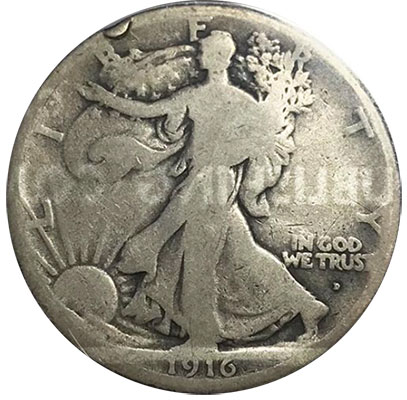 By the way, The E-Sylum is a newsletter sent to your email for free, and it’s my favorite read each week. Write Editor Wayne Homren at [email protected] to sign up. Drop my name, and he may extend my free subscription!
By the way, The E-Sylum is a newsletter sent to your email for free, and it’s my favorite read each week. Write Editor Wayne Homren at [email protected] to sign up. Drop my name, and he may extend my free subscription!
NATURAL PHENOMENA DEPARTMENT
With this issue featuring an item about my article on Whitman folders in The Numismatist, this seems like a good opportunity to run a photo that pertains to that subject. More specifically, it pertains to the way in which coins stored in such folders may develop very distinctive toning.
In this instance, a 1916-D half dollar stored for many years inside the Whitman folder for Liberty Standing Half Dollars (Publisher No. 9021) reacted with its printed end flap in a most peculiar manner. The letters of the title actually masked the reactive paper from toning the coin in stencil fashion, and this resulted in the reversed text appearing on the coin as untoned metal. I’ve seen this selective toning on many coins, and it’s particularly aggressive on ones that were cleaned before insertion into the folder. What does it say on your coins?
Best Regards,
—David W. Lange, coincollectingboards.com
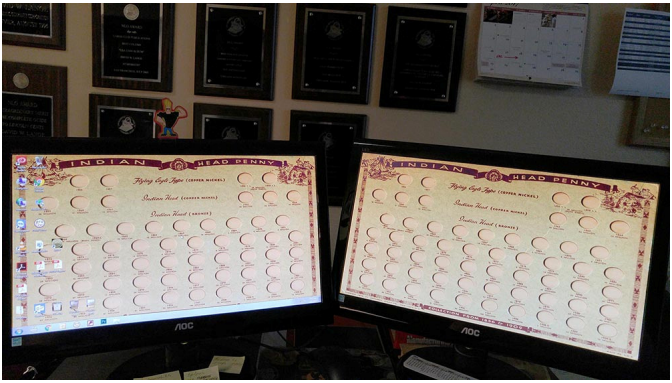
The author’s desktop, featuring Gramercy coin boards as his computer wallpaper. Photo courtesy David W. Lange





How and where can I get my collection appraised?
Collection of coin boards?